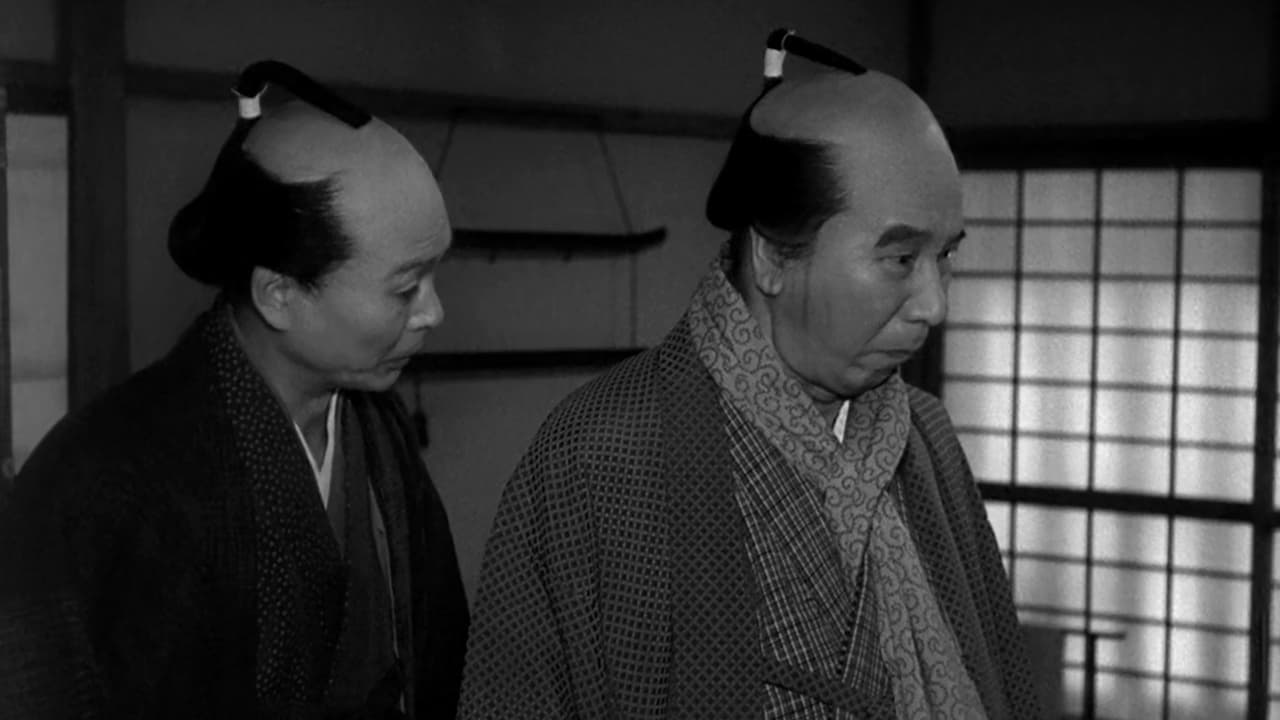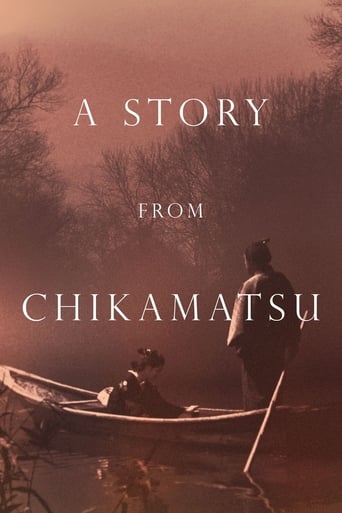

You won't be disappointed!
... View MoreEach character in this movie — down to the smallest one — is an individual rather than a type, prone to spontaneous changes of mood and sometimes amusing outbursts of pettiness or ill humor.
... View MoreGreat example of an old-fashioned, pure-at-heart escapist event movie that doesn't pretend to be anything that it's not and has boat loads of fun being its own ludicrous self.
... View MoreThis is a dark and sometimes deeply uncomfortable drama
... View More"Chikamatsu Monogatari" , (aka "The Crucified Lovers"), is one Mizoguchi's lesser known works and yet it is no less extraordinary for all that. It is, of course, typical of its director; another tragic tale of corrupted innocence and the terrible hand fate plays in people's lives, in this case a wrongful accusation of adultery over a very simple misunderstanding. Shakespeare could have written this.It's set in the 17th century and it paints as relentless a picture of cruelty and hypocrisy as Mizoguchi has given us and he shoots it almost in semi-darkness, (even the exteriors take place at night or are shrouded in mist or in shadow), so there is no escape for its protagonists nor for us; the inevitability of the lovers' fate is clearly signposted from the beginning.As the couple forced to acknowledge their love for each other by unfolding events Kazuo Hasegawa and Kyoko Kagawa are superb, particularly Kagawa whose performance as the wronged wife is a masterclass in subtlety and tenderness. This is surely one of the key films in all of Japanese cinema.
... View MoreMizoguchi is acclaimed for all of his work, but is mostly praised for the succession of masterpieces he directed at the end of his career. "The Crucified Lovers" is my favourite. Note the original title means "A Tale From Chikamatsu", after the classic Japanese author Chikamatsu Monzaemon who wrote the early 18th century play the movie is based on.It is a rare film where each image is finely crafted as a piece of art, yet without ostentation. "We must clean our eyes between each shot", Mizoguchi said: he perfectly applies this precept here. Each shot is meaningful, none feels superfluous.*** WARNING: CONTAINS SPOILERS ***The movie narrates a love story, yet with important social and psychological themes, as show the regular alternation between the lovers' scenes and others. It depicts a harsh society where nobles rule ruthlessly, money reigns, people are dominated by conventions and adultery is punished by crucifixion. Traditions overrule everything including family bonds: Mohei's father rejects his son instead of helping him and denounces him (even if he frees him afterwards); O-Tama's uncle blames his niece for a petty lie; O-San's family blames her and finally gives her up. Women are the main victims: O-San's family decided to marry her to a much older, despicable man; he cheats on her but she has to go; O-Tama is abused but also has to go.It is a world of corruption and hypocrisy: Ishun condemns the adulterous lovers at the beginning but cheats on his wife; Isan pretends he is concerned by Ishun's misfortune but conspires for his downfall; Sukeimon betrays his master; there are political intrigues involving debts and law. This society seems doomed to carry on, as show recurring events and symbols: the output of the printing house is calendars issued every year; the chestnut merchant comes every year; there is a crucifixion at the beginning and another one at the end; when Ishun is eventually discharged, Isan who will take over looks just as vile (though more intelligent, perhaps).In this context, the love story is all the more compelling since O-San and Mohei fight against everything: law, reputation, conventions, family. The scenes between the lovers become increasingly intense. Eventually when they are condemned, they look happy because they can remain together even if they die.Images express how their relationship liberates them. At the beginning they are suffocating in the printing house: it is filled with people, objects, beams, screens, shadows and even spider webs when Mohei is held captive. O-San has financial issues. Mohei is sick. When they run away, they are first obliged to take shelter in dark places and hide between huge barrels that seem to crush them. However, when and after they voice their love, they are in nature: despite the difficult situation, it feels as if we can breathe. A unique shot shows there is no going back: as Mohei runs down a hill followed by O-San, the camera pivots down on the two characters lost in the endless slope. It signifies in a simple, powerful way the intensity of their love but also how it will lead them to irreversible consequences.However this liberation is short-lived: after Mohei's father refuses to help them, they are confined in a small dark hut. Then they are held inside again. The movie ends on a stunning camera movement, zooming high out of the lovers among the crowd. It is the only such movement in the film, making it more gripping (somewhat reversed from the above-mentioned shot on the hill, although in the latter the camera pivots down without zooming): it magnificently summarises the love story surrounded by a hostile society.Mizoguchi's images are more than masterly: they are metaphysical. He shows a high respect for oppressed characters: they are framed close and the camera discreetly follows them, slightly going up as they come closer or going down as they kneel, which happens frequently. He also demonstrates decency: the shot becomes distant when the scene grows too personal, for instance when the lovers spend their first night together or in the example below. These superb aesthetics show even in apparently simple scenes. Just one example: when O-San meets O-Tama in her room at the beginning of the movie.Shot 1: general view of the room. O-San enters, moves forward and kneels while O-Tama moves to the back. The camera adjusts to O-San as described above.Shot 2: closer image precisely when O-Tama moves forward. This subtle coordination of movement (image and character) makes the shot transition look completely natural. We get closer as the conversation becomes more intimate.Shot 3: even closer image, from the opposite side of the room, precisely when O-Tama turns around. Again, the transition is fluid and the close image shows the increasing intimacy. The opposite shot illustrates the shock of O-Tama's revelation: Ishun is abusing her. Music rises at the end.Shot 4: same as shot 1 but we now see the two women from the back since they have turned around. The camera has resumed its initial, distant position out of consideration for the despaired characters. Both women are faceless: dominated, denied a proper existence. The music insures the transition with shot 3 and highlights their sorrow.Hence in just four seemingly plain shots (of which two are similar), Mizoguchi reveals the characters' emotions and condition. The scene lasts a bit more than two minutes but embodies a whole story. One jewel amidst many others.A last note about the score. The aggressive music during the opening credits announces a movie without compromise: be ready for an aesthetical and emotional experience. During the film, the score delicately beautifies scenes (e.g. the discreet bells when Mohei is captive at the beginning). Eventually, the music becomes more aggressive (e.g. at O-San's family's house), and the movie ends on notes similar to the beginning: the inevitable tragedy has unravelled.
... View MoreSome time ago, I had the opportunity to attend an Ichibana lecture and demonstration. It was given by those close to emperor and was tailored for westerners. That meant that there were plenty slides that contrasted western flower arranging with this highest Japanese art. The western values all had to do with perfect symmetry, balance, coherent, simple shapes. Each element should be beautiful by itself. Harmonies were all within this lovely melody of perfect pace. Bach.Contrasted with this was the Ichibana we saw constructed before us. Dissymmetries, tension, motion and peace. Some elements were dead, even damaged. The base or container was as likely to be misshapen, even ugly. Where the western arrangements were music, this was life. It had soul, katachi. The whole thing was quite an experience for me and was my most visceral introduction to a corner of Japan that I have since enfolded into my own life and eye. At the root of this is dissymmetry (which is different from asymmetry), the presence of items that have sibling states which are not expressed. It gives a tension that springs, the pumps blood and makes real beauty because it provides space for the definition of beauty.This is one of the reasons I appreciate Kurosawa. He understood this, and is why I eagerly watch recommended Japanese films. And why I came to this. Surely Mizoguchi is one of the most celebrated Japanese filmmakers. But what I'm experiencing with him lacks that katachi, that clean, beauty of tension I wished for. What I see is comparatively western. Oh, the story is traditionally Japanese, and the manner of the story. But everything cinematic is perfectly constructed, balanced. Every frame is a masterpiece of construction, and in three dimensions. Its geometric, its rich, its balanced, every vision. Every bit is lovely, every motion perfect, every jot complemented.Its not Ichibana. Its too pretty to be beautiful. Its too Methodist.Ted's Evaluation -- 2 of 3: Has some interesting elements.
... View More"Chikamatsu Monogatari" (Crucified Lovers) (Japanese, 1954): Set in 17th century Japan, a series of honorable gestures begins to go terribly wrong, and takes victims with them. Did you know that adulterers at that time were crucified in Japan? This and many more traditions of the Old Way were up for reexamination by the Japanese culture soon after their defeat in World War II. This must have been a time of great doubt for them after all, wasn't it their past that lead them to their current condition? "Chikamatsu Monogatari" is an elegant, methodical story with tragic twists and turns that never the less head straight into inflexible Fate.
... View More